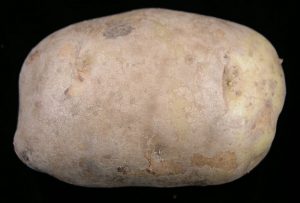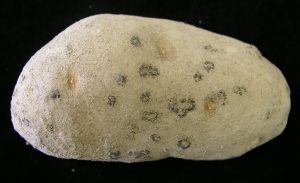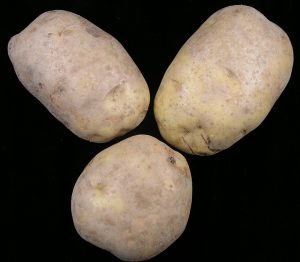Bulletin #2444, Silver Scurf of Potato
Bulletin #2444, Silver Scurf of Potato (PDF)
By Steven B. Johnson, Extension Crops Specialist, University of Maine Cooperative Extension
For information about UMaine Extension programs and resources, visit extension.umaine.edu.
Find more of our publications and books at extension.umaine.edu/publications/.
Helminthosporium solani, a fungus, causes silver scurf disease of potatoes. The disease is present throughout potato production areas in the United States and has been on the increase over the past fifteen to twenty years. The pathogen causes a surface blemish on tubers and does not affect other parts of the potato plant. The disease does not cause yield loss in the field but can cause economic loss owing to rejection of crops with surface blemishes present. Diseased tubers tend to have increased water loss in storage, and may have increased susceptibility to secondary pathogens present in the storage. All potato cultivars are susceptible to the pathogen, but cosmetic losses are greatest on smooth-skinned varieties intended for the fresh market. Infection is initiated in the field, but disease development occurs in storage.
Symptoms
Helminthosporium solani produces superficial lesions, as it only infects the periderm, or skin, of the potato tuber. Infection occurs in the field. The easily overlooked lesions are small and irregularly shaped. Tubers that do not show lesions at harvest may develop symptoms in storage. Lesions can range from tan to gray to black in color. In storage, silver scurf lesions develop into larger, circular lesions, often with a distinct dark margin. Spores of H. solani on the lesion margin cause the darker color. Individual lesions may coalesce and can eventually cover a large portion of the tuber surface. When the lesions are wet, they may have a silvery appearance.
Disease Cycle
While H. solani can survive in the soil for up to two years in the absence of potatoes, the main source of inoculum for silver scurf is infected seed tubers. Silver scurf is primarily a seed-borne disease. Infection occurs through lenticels or directly through the tuber periderm; the pathogen does not require a wound for an infection site. The longer potatoes remain in the field following vine kill, the more infection takes place.
Lesions initiated in the field continue to develop in storage. Helminthosporium solani spores spread from infected to healthy tubers during the harvest and handling of the crop. As they do, considerable secondary spread can occur, potentially affecting all tubers. The suberization period is an ideal environment for the silver scurf pathogen. The longer tubers spend in storage, the greater the potential for increased disease incidence. New H. solani spores develop on lesions and spread through the storage, usually through the air-handling system. This will occur with humidities higher than 90% and temperatures greater than 38ºF. Condensation, resulting in free moisture on the tubers, provides ideal infection conditions. The lower the temperature, the slower the disease spread will be. Generally, symptoms appear after about four months of storage. One infected lot has the potential to infect all other lots in the building. Contamination of concrete, wood, or other organic matter with spores from previous crops can also serve as inoculum that can spread through the storage.
Control
Crop rotations with more than two years between potato crops will reduce the soil-borne inoculum. Thoroughly clean and disinfect storages and cutting and handling equipment. Use seed that is as free as possible of the disease. There are seed-treatment options for treating seed or planting furrows to reduce the pathogen spread from the seed piece to the daughter tubers. However, seed treatments are not a replacement for healthy seed.
Tubers increase in susceptibility to infection as they mature. The longer the period between vine-kill and harvest, the higher the incidence and severity of infected tubers. Timely harvest can reduce the amount of tuber infection. Limiting the amount of soil brought into the storage with the harvested tubers will help reduce disease development and spread in storage.
Application of a postharvest product for silver scurf control has proven to be effective in suppressing levels in long-term storage situations. Use of products in ventilation systems has not proven effective in reducing silver scurf.
Cooler temperatures, lower relative humidity, and adequate ventilation retard silver scurf development. These conditions only slow silver scurf development: the disease continues to progress, albeit at a slower rate. Avoid conditions that create condensation or free water on the tubers. Rapidly remove free moisture from wet tubers brought into the storage. Avoid repeated access to and unloading of the storage as this releases H. solani spores, which spread and frequently result in secondary infections.
Reviewed by Assistant Professor of Plant Pathology J. Hao.
Information in this publication is provided purely for educational purposes. No responsibility is assumed for any problems associated with the use of products or services mentioned. No endorsement of products or companies is intended, nor is criticism of unnamed products or companies implied.
© 2016, 2020
Call 800.287.0274 (in Maine), or 207.581.3188, for information on publications and program offerings from University of Maine Cooperative Extension, or visit extension.umaine.edu.
In complying with the letter and spirit of applicable laws and pursuing its own goals of diversity, the University of Maine System does not discriminate on the grounds of race, color, religion, sex, sexual orientation, transgender status, gender, gender identity or expression, ethnicity, national origin, citizenship status, familial status, ancestry, age, disability physical or mental, genetic information, or veterans or military status in employment, education, and all other programs and activities. The University provides reasonable accommodations to qualified individuals with disabilities upon request. The following person has been designated to handle inquiries regarding non-discrimination policies: Director of Equal Opportunity and Title IX Services, 5713 Chadbourne Hall, Room 412, University of Maine, Orono, ME 04469-5713, 207.581.1226, TTY 711 (Maine Relay System).




